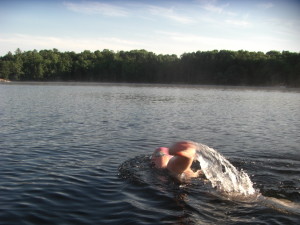Fuel Along The Way:
It has been my experience and other marathon swimmers’ experience that it is difficult to digest solid food while swimming. This means that it is best to have breakfast 2 hours before you swim if possible and to use easily digestible foods and liquids when you are doing a long continuous swim. This way, the food will not sit in your stomach undigested (not a nice feeling when swimming). Everyone is different when it comes to refueling during endurance activities. I typically fuel with “gels” and sport drinks. Some find meal substitutes like Boost helpful, or blended fruit in syrup. Others tolerate sandwiches with peanut butter and jam or hummus and chutney. I also bring along raisins and fig newton-like bars, and drink lots of fluids. Water or sports drinks are extremely important.
Joy Greene, the woman that introduced me to distance swimming used to eat Jello, hot chocolate, plain chocolate (bar) and Gatorade. Liz Yetisir found that breaking every 30 minutes for fluid, and hourly for something to eat, worked very well for her.
The frequency of fuel breaks is different for everyone. Some literature that I have read suggests breaking every 15 minutes for fluid. . . but it’s a bit of trial and error. I broke every hour the first year and that was not often enough; every 15 minutes the second year and that was too often. Now I typically break every 45 minutes. Most importantly, we are all different when it comes to re-fueling during an endurance event so plan some long swims and trying different combinations out before the Swim for the Cure.
Equipment Checklist
Sunscreen, extra goggles, towel, change of clothes for the end, extra bathing cap — I will be supplying the official yellow Swim for the Cure bathing cap — anti-chafing cream (if needed), waterproof MP3 player (if desired or available), fluids / food for breaks for you and your crew.
You can do it!
You will be amazed at how far you can actually swim. Training is important, but I had not swum farther than six miles before completing my first 11-mile swim. I really hurt by the time I was done, but I did it! Depending on your training distance, you may find swimming longer than your usual swims challenging. You may feel very tired and your swimming stroke may slow down, feeling like it takes a lot of effort to continue swimming. You will be able to swim through this feeling and having more frequent breaks with gels and lots of fluids may be very helpful. Tell your crew when you are feeling like this and they will be able to help with higher calorie “fuel” and really encourage you to drink lots of fluids to keep you hydrated.

